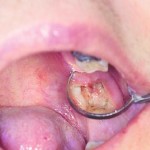 Dry socket or alveolar osteitis is a complication of delayed healing following tooth extraction. Dry socket occurs when the blood clot is lost from its socket exposing the bone to air, bacteria and fluid. Loss of blood clot can be due to excessive fibrinolytic activity caused by bacterial, salivary factors and etc. (For your information, fibrinolysis is a process that prevents blood clot from forming) In the absence of a blood clot, healing of the extraction site is delayed because soft tissue must grow from the gum margins to cover the bone and fill the extraction socket.
Dry socket or alveolar osteitis is a complication of delayed healing following tooth extraction. Dry socket occurs when the blood clot is lost from its socket exposing the bone to air, bacteria and fluid. Loss of blood clot can be due to excessive fibrinolytic activity caused by bacterial, salivary factors and etc. (For your information, fibrinolysis is a process that prevents blood clot from forming) In the absence of a blood clot, healing of the extraction site is delayed because soft tissue must grow from the gum margins to cover the bone and fill the extraction socket.
Dry socket symptoms:
-Â Â Â Â Â Â Â Â Â Dull aching to severe throbbing pain around the extraction site. Dry socket pain normally develops on the third or fourth day after removal of tooth.
-Â Â Â Â Â Â Â Â Â Pain which radiates from the extraction socket to your ear.
-Â Â Â Â Â Â Â Â Â Pain which cannot be relieved by using aspirin or paracetamol.
-Â Â Â Â Â Â Â Â Â Bad breath (halitosis) or foul smell coming from the area of extraction socket.
Contact your dental practitioner if you suspect that you are having dry socket based on the symptoms mentioned above. The diagnosis of dry socket is confirmed through history and clinical findings of the dental practitioner.
What other causes of post extraction pain are there?
-Â Â Â Â Â Â Â Â Â Pain from surgical trauma to oral tissues can happen when surgery/extraction is difficult. However pain starts immediately after trauma occurs and they respond well to pain killers.
-Â Â Â Â Â Â Â Â Â Fractured mandible can cause post extraction pain. It might be considered as a diagnosis of post extraction pain if you are having swelling and bruising around the area.
-Â Â Â Â Â Â Â Â Â Retained root fragments.
 Dry socket is most often found in
-Â Â Â Â Â Â Â Â Â Extraction of lower teeth especially removal of wisdom tooth.Â
-Â Â Â Â Â Â Â Â Â Traumatic extraction which involves removal of certain amount of bone.
-Â Â Â Â Â Â Â Â Â Female patients, especially if they are taking contraceptive pills
-Â Â Â Â Â Â Â Â Â Patients who smoke. Smoking is a well known cause to delay healing process.
-Â Â Â Â Â Â Â Â Â Diabetic patients.
-Â Â Â Â Â Â Â Â Â History of previous dry socket.
-Â Â Â Â Â Â Â Â Â Patients who do not follow post operative instructions (they suck on a straw, spit , sneeze vigorously)
 Treatment of dry socket (What will the dental practitioner do)
- Gently irrigate the extraction socket with warm saline solution of 0.12 % chlorhexidine to remove any foreign debris.
- Your dental practitioner should not curette any bone (insert instrument to scrap off bone) This will increase your pain and the amount of exposed bone.
- A dressing will be placed into the extraction socket to prevent impaction of food into the socket. You will feel immediate relief from pain within 5 minutes. There are many types of dressing available but effective socket cleansing and socket hygiene are more important than the type of dressing used.
- Change the dressing every day or every other day for next 3 to 6 days, depending on the severity of the pain. The extraction socket should be irrigate/clean gently with saline at each dressing change. Dressing should not be replaced after the pain has stopped. It will act as a foreign body and further prolongs wound healing.
-   Non steroidal anti inflammatory drug such as ibuprofen is normally prescribed by the dental surgeon for pain relief. Antibiotics are not given in this case since dry socket is not associated with infection.
 What can the dentist do to prevent dry socket?
 –       Gentle management of tissues and minimize trauma during surgery.
-Â Â Â Â Â Â Â Â Â Clean incisions should be done.
-Â Â Â Â Â Â Â Â Â Area of surgery should be irrigated and debrided with large amount of saline to wash away foreign debris. This will prevent bacterial contamination.
-Â Â Â Â Â Â Â Â Â Small amount of antibiotics such as tetracycline can be placed in the socket to decrease the incidence of dry socket.
What can you do to prevent dry socket?
-Â Â Â Â Â Â Â Â Â Avoid smoking to prevent delayed healing
-Â Â Â Â Â Â Â Â Â Avoid excessive rinsing and drinking through straw.
-Â Â Â Â Â Â Â Â Â Maintain oral hygiene and keep extraction area clean.
-Â Â Â Â Â Â Â Â Â Follow post operative instructions given by your dental practitioner (avoid smoking, excessive spitting, using of straw after extraction)
Click the link below to read more about post extraction instructions.
http://www.intelligentdental.com/2011/03/26/care-of-mouth-after-tooth-extraction/
Â